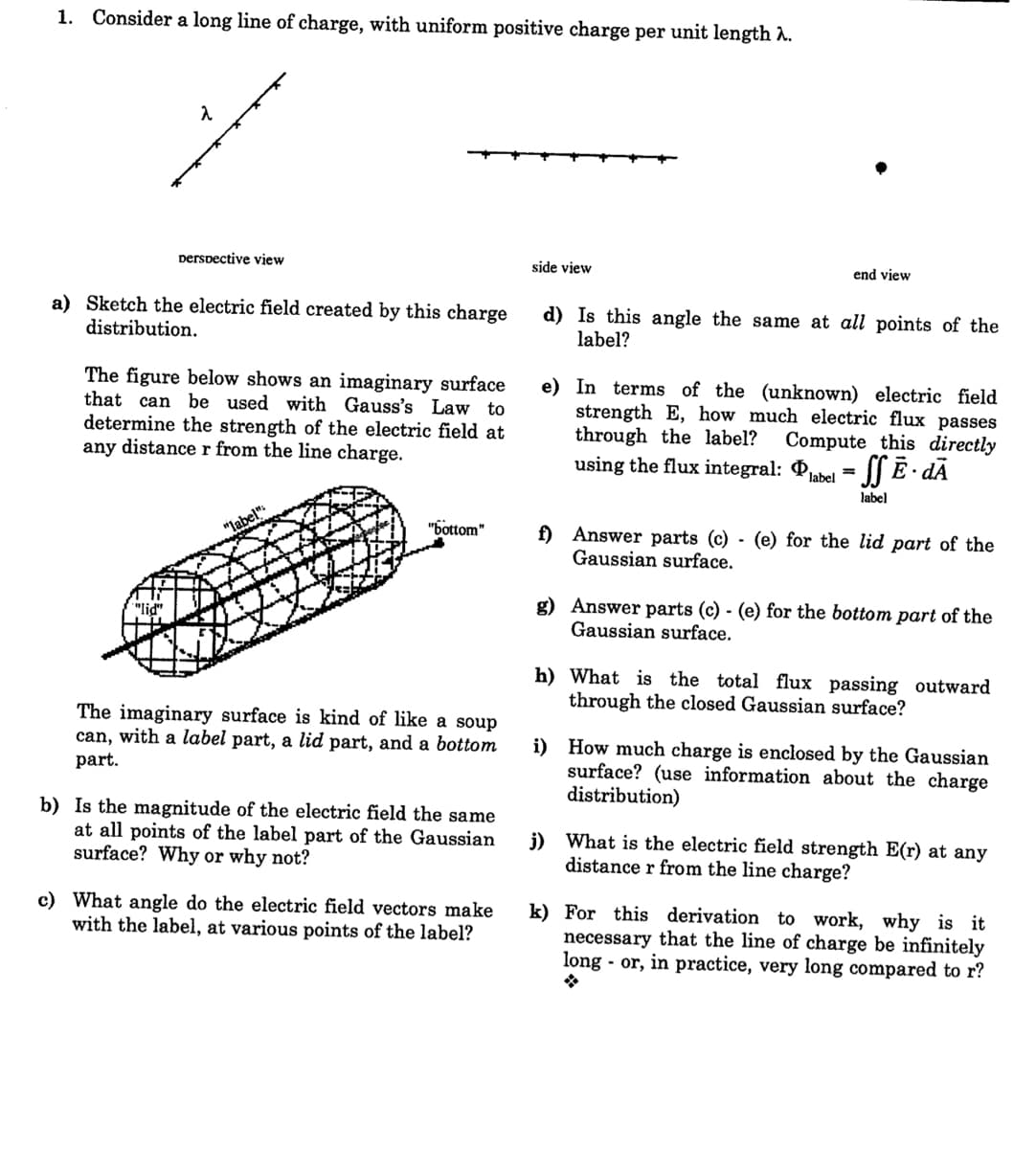Sketch the electric field created by this charge distribution. The figure below shows an imaginary surface that can be used with Gauss's Law to determine the strength of the electric field at any distance r from the line charge. "label" "bottom" "lid" The imaginary surface is kind of like a soup can, with a label part, a lid part, and a bottom part. Is the magnitude of the electric field the same at all points of the label part of the Gaussian surface? Why or why not? What angle do the electric field vectors make with the label, at various points of the label?
Sketch the electric field created by this charge distribution. The figure below shows an imaginary surface that can be used with Gauss's Law to determine the strength of the electric field at any distance r from the line charge. "label" "bottom" "lid" The imaginary surface is kind of like a soup can, with a label part, a lid part, and a bottom part. Is the magnitude of the electric field the same at all points of the label part of the Gaussian surface? Why or why not? What angle do the electric field vectors make with the label, at various points of the label?
Power System Analysis and Design (MindTap Course List)
6th Edition
ISBN:9781305632134
Author:J. Duncan Glover, Thomas Overbye, Mulukutla S. Sarma
Publisher:J. Duncan Glover, Thomas Overbye, Mulukutla S. Sarma
Chapter4: Transmission Line Parameters
Section: Chapter Questions
Problem 4.34MCQ
Related questions
Question
Please answer j and k

Transcribed Image Text:1. Consider a long line of charge, with uniform positive charge per unit length A.
perspective view
side view
end view
a) Sketch the electric field created by this charge
distribution.
d) Is this angle the same at all points of the
label?
The figure below shows an imaginary surface
that can be used with Gauss's Law to
determine the strength of the electric field at
any distancer from the line charge.
e) In terms of the (unknown) electric field
strength E, how much electric flux passes
through the label?
using the flux integral: ,
Compute this directly
S È• dÃ
label =
label
"bottom"
f) Answer parts (c) - (e) for the lid part of the
Gaussian surface.
g) Answer parts (c) - (e) for the bottom part of the
Gaussian surface.
h) What is the total flux passing outward
through the closed Gaussian surface?
The imaginary surface is kind of like a soup
can, with a label part, a lid part, and a bottom
i) How much charge is enclosed by the Gaussian
surface? (use information about the charge
distribution)
part.
b) Is the magnitude of the electric field the same
at all points of the label part of the Gaussian
surface? Why or why not?
j) What is the electric field strength E(r) at any
distance r from the line charge?
c) What angle do the electric field vectors make
with the label, at various points of the label?
k) For this derivation to work, why is it
necessary that the line of charge be infinitely
long
- or, in practice, very long compared to r?
Expert Solution
This question has been solved!
Explore an expertly crafted, step-by-step solution for a thorough understanding of key concepts.
Step by step
Solved in 2 steps with 2 images

Knowledge Booster
Learn more about
Need a deep-dive on the concept behind this application? Look no further. Learn more about this topic, electrical-engineering and related others by exploring similar questions and additional content below.Recommended textbooks for you

Power System Analysis and Design (MindTap Course …
Electrical Engineering
ISBN:
9781305632134
Author:
J. Duncan Glover, Thomas Overbye, Mulukutla S. Sarma
Publisher:
Cengage Learning

Power System Analysis and Design (MindTap Course …
Electrical Engineering
ISBN:
9781305632134
Author:
J. Duncan Glover, Thomas Overbye, Mulukutla S. Sarma
Publisher:
Cengage Learning